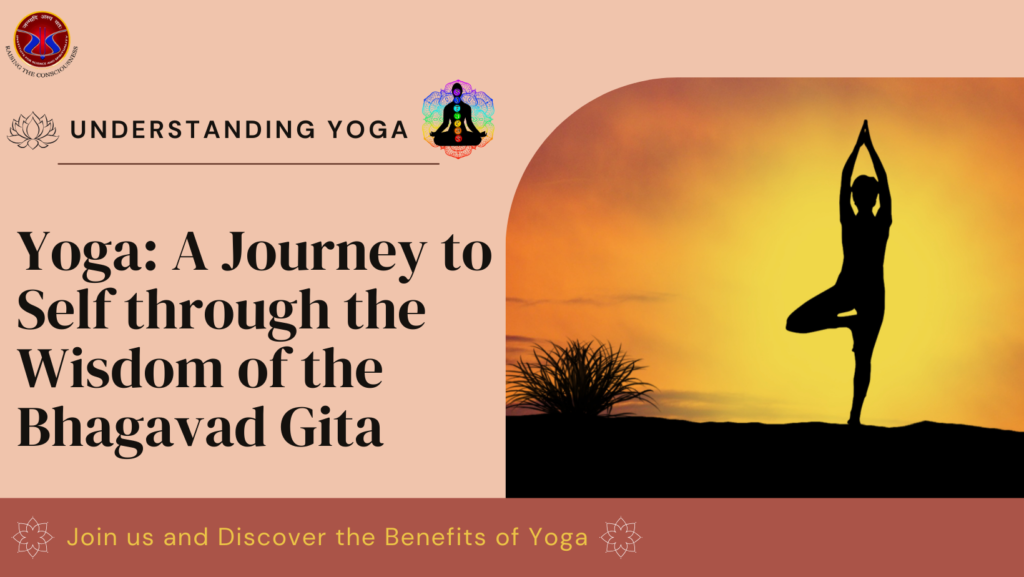Table of Contents:
- Introduction
- Understanding Yoga via the Bhagavad Gita
- Various Yoga disciplines in the Gita
- Essence of Yoga Routine
- Integrating Physical Yoga into Everyday Routine
- Studying the Teachings of the Bhagavad Gita
- The Path of Selfless Action
- The Path of Devotion
- The Path of Knowledge
- The Path of Meditation
- Conclusion
Introduction
Yoga, deeply connected to ancient Indian customs, provides a comprehensive approach to harmonizing the mind, body, and spirit. This manual explores the extensive advantages and spiritual aspects of yoga as explained in the Bhagavad Gita. More than just physical training, yoga represents a powerful process towards self-realization, mental focus, emotional stability, and spiritual awakening.
Understanding Yoga via the Bhagavad Gita
The Bhagavad Gita views yoga as more than just physical activity, emphasizing it as a structured way of life to attain balance and oneness with the cosmos. It describes a holistic method for achieving self-awareness and tranquillity internally by practicing different types of yoga that cater to diverse spiritual tendencies and life journeys.
Yoga is described as a pursuit for inner peace and profound self-discovery, going beyond physical aspects to reach the depths of the soul. It is often summarized by the idea that it is a journey within oneself, towards oneself.
Various Yoga disciplines in the Gita
Advocates selfless action and dedication to duty without attachment to results, exemplified by offering charitable work without expecting acknowledgment. Emphasizes unconditional love and devotion toward the divine in Bhakti Yoga, fostering a deep emotional connection. This is demonstrated through daily meditation or prayer focused on a personal deity to cultivate a loving relationship with the divine. Jnana Yoga focuses on pursuing spiritual knowledge and understanding, discerning the real from the unreal by studying sacred texts and contemplating their teachings for insight into one’s true nature. Dhyana Yoga encourages deep meditation for tranquillity and enlightenment, achieved through regular mindfulness or concentration techniques for mental clarity and peace.
Essence of Yoga Routine
Practice fundamental yoga postures like Tadasana (Mountain Pose) to establish a strong and stable base. Incorporate breathing techniques like Anulom Vilom (Alternate Nostril Breathing) to boost energy levels and mental focus. Start with brief meditation practices, concentrating on the breath or a mantra, to develop awareness and serenity within.
Integrating Physical Yoga into Everyday Routine
Commencing Your Routine
Reflect on your reasons for practicing, whether it be to find tranquillity, improve health, or enhance spiritual development. Make sure your practice is in line with these objectives for a purposeful and satisfying experience.
Set up a calm environment that promotes concentration and peace, without any disruptions, to enhance your practice.
Prepare yourself with essential gear like a yoga mat and comfortable attire to support a safe and efficient practice.
Studying the teachings of the Bhagavad Gita
- Karma Yoga in Action: Engage in volunteer work without expecting acknowledgment, embodying selfless action as a spiritual practice.
The Path of Selfless Action
Shloka 2.47: “कर्मण्येवाधिकारस्ते मा फलेषु कदाचन। मा कर्मफलहेतुर्भूर्मा ते सङ्गोऽस्त्वकर्मणि।।”
“Your right is to work only, but never to its fruits. Let not the fruits of action be your motive, nor let your attachment be to inaction.”
This verse emphasizes the essence of Karma Yoga—performing one’s duty without attachment to the outcomes. It teaches the practitioner to focus on the present action, contributing selflessly and efficiently, without being swayed by the desire for personal gain.
- Bhakti Yoga through Devotion: Show devotion by performing personal rituals like lighting candles or presenting flowers to a deity.
The Path of Devotion
Shloka 9.26: “पत्रं पुष्पं फलं तोयं यो मे भक्त्या प्रयच्छति। तदहं भक्त्युपहृतमश्नामि प्रयतात्मनः।।”
“If one offers Me with love and devotion a leaf, a flower, fruit, or water, I will accept it.”
This verse captures the essence of Bhakti Yoga, where even the simplest offerings, when made with devotion and a pure heart, are valued by the divine. It underscores the importance of love, sincerity, and dedication in one’s spiritual practice.
- Jnana Yoga for Insight: Participate in study groups to discuss philosophical texts and apply their teachings to comprehend life’s profound truths.
The Path of Knowledge
Shloka 4.38: “न हि ज्ञानेन सदृशं पवित्रमिह विद्यते। तत्स्वयं योगसंसिद्धिः कालेनात्मनि विन्दति।।”
“In this world, there is nothing as sublime and pure as transcendental knowledge. It is the mature fruit of all mysticism, and one who has achieved this enjoys the self within himself in due course of time.”
This shloka highlights the supreme value of spiritual knowledge in Jnana Yoga. It suggests that transcendental knowledge—understanding the true nature of the self and the universe—is the highest form of purification, leading to self-realization and liberation.
- Dhyana Yoga for Peace: Cultivate inner peace through guided meditation or quiet contemplation in nature to achieve a tranquil mind and connect with the essence of existence.
The Path of Meditation
Shloka 6.26: “यतो यतो निश्चरति मनश्चञ्चलमस्थिरम्। ततस्ततो नियम्यैतदात्मन्येव वशं नयेत्।।”
“From wherever the mind wanders due to its flickering and unsteady nature, one must certainly withdraw it and bring it back under the control of the Self.”
This verse speaks to the practice of Dhyana Yoga, emphasizing the importance of controlling the mind through concentration and meditation. It acknowledges the mind’s tendency to wander and presents meditation to achieve mastery over it, leading to inner peace and self-awareness.
The verses from the Bhagavad Gita provide deep understanding of the different types of yoga and help individuals lead a balanced, purposeful, and spiritually rich life. Each path has its own emphasis and techniques that aid in the overall growth of a person, moving them towards complete freedom (Moksha).
Conclusion
The Bhagavad Gita provides deep guidance on yoga, presenting a meaningful structure for individual development and spiritual enlightenment. By incorporating its insights into our routines, we initiate a powerful process leading us towards self-discovery, inner tranquillity, and alignment with the cosmos. Yoga represents an enduring voyage of exploration, obstacles, and satisfaction, directing us towards the aim of enlightenment and connection with the sacred.



